| Tudor City: A Brief History of the City on the Hill
"What is Tudor City? A city within a city, a garden spot in the center of New York."
With that description, which appeared in a promotional brochure in the late 1920s, real estate developer Fred French sought to lure tenants to Tudor City, his vision of an urban Utopia-- a "human residential enclave" that boasted "tulip gardens, small golf courses, and private parks."
At the time, the waterfront along the East River had turned to squalor as noxious meat packing houses, a gas works plant, and a glue factory fractured the landscape. It was French's vision that Tudor City would be positioned high up on Prospect Hill, rising above the stench and creating an urban oasis characterized by a strong feeling of community.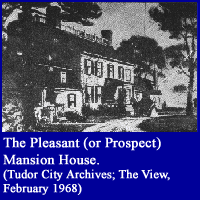
It was a goal worthy of an area rich in New York City history. In 1636 a tobacco plantation was established on the site. It was part of Turtle Bay Farm, a 40-acre parcel of land granted by the Dutch governor of Niew Amsterdam to two Englishmen, George Holmes and Thomas Hall.
To this day, there is much discussion as to this use of the word "Turtle." Some sources claim that turtles indeed inhabited the bay, while the more accepted explanation is that the name is a corruption of the Dutch word "deutel," meaning barrelhead, which was used to describe the shape of the bay. Semantics aside, Turtle Bay Farm passed hands several times until its purchase in 1792 by Francis B. Winthrop for £1500. By some accounts, Winthrop is credited with the construction of Mount Pleasant Mansion on Prospect Hill, in what is now the center of 41st Street between Windsor and Tudor Towers. Another reference, the Randall Map, shows it standing at the intersection of First Avenue and an extension of 41st Street. Yet another account attributes construction of the Mansion to James Beekman and places it around today's 50th Street.
Despite these differing theories, one thing is certain: the area was topologically spectacular. Edgar Allen Poe is known to have rowed all the way up to and around Blackwell Island, now Roosevelt Island, reveling in scenery of "frame and antique houses," "magnificent cliffs," and "stately trees." At the same time, Poe bemoaned pending plans to break up the city into grids and squares that would eventually give rise to housing developments.
From Estates to Slums
The rate of growth of New York City in the 1850s was impressive but uneven. The spectacular hills were razed to provide cross streets and avenues were paved, but development focused mostly on the northern part of the city. In midtown, the area around Fifth and Madison Avenues was sparsely settled--while, according to one census report, more than 10,000 squatters inhabited the area "north of 42d street and in communities, such as Dutch Hill between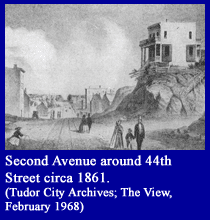 38th and 44th streets along the East River." By the time of the Civil War, the magnificent estates had been replaced by modest housing. Prospect Hill became known as Goat Hill as goats and squatters overran the area, ruled by an ill-reputed Paddy Corcoran and his "Rag Gang." The headquarters of "Corcoran's Roost" is thought to be where Prospect Tower stands today. An inscription on Tudor Tower also commemorates this piece of infamous history. 38th and 44th streets along the East River." By the time of the Civil War, the magnificent estates had been replaced by modest housing. Prospect Hill became known as Goat Hill as goats and squatters overran the area, ruled by an ill-reputed Paddy Corcoran and his "Rag Gang." The headquarters of "Corcoran's Roost" is thought to be where Prospect Tower stands today. An inscription on Tudor Tower also commemorates this piece of infamous history.
Adding to the notoriety were the anti-draft riots that began at the registration office on 46th Street and Third Avenue and spread quickly. The residents of Goat Hill apparently joined a mob of 50,000 that marched to Cooper Square. Rioting ensued for three days as sections of the city were burned and houses were looted. Some of the bounty was later found in the shanties of "Corcoran's Roost."
The post-Civil War era brought even more changes. By 1868, slaughterhouses, packing sheds, cattle pens, and railroad piers marked the area. As the waterfront continued to be commercialized, middle class housing was constructed in the form of row houses. Four of these row houses still stand -- one on the North side of 41st Street and the other three on the South side of 43rd Street. The construction of the Second and Third Avenue Els also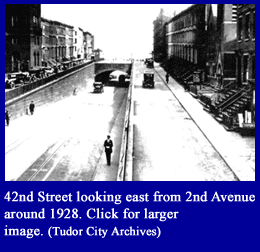 contributed to the industrialization of the East River, and middle class families soon fled to the suburbs. As a result, the row houses were converted to rooming houses or replaced by tenements. By the 1920s, the area had become a slum. contributed to the industrialization of the East River, and middle class families soon fled to the suburbs. As a result, the row houses were converted to rooming houses or replaced by tenements. By the 1920s, the area had become a slum.
The French Vision
The 1920s also saw a resurgence of construction. Real estate developer Fred French reasoned that people who had moved to the suburbs needed to commute back to the city by train through Grand Central Station. Revitalizing Prospect Hill provided a perfect opportunity: inexpensive land near the commercial hub and the desire of workers to be near their jobs. To finance the development, he created The French Plan, which consisted of a co-investment plan between the French Company and tenant/owners. His goal was not so much to garner huge profits, but rather "small profit on a large business." Net profits were used to repay investors and provide dividends before distribution was made to the French Company.
Tudor City was considered "the real estate investment of the future" and the largest housing project in Manhattan to date. Architecturally, it borrowed from the trend to develop suburban housing in a mock Tudor style. The architecture of Tudor City is actually a mix of early 16th Century Tudor and late 16th Century Elizabethan -- an "outward-looking mix of Gothic and Renaissance style."
French's vision was to create an apartment complex with a suburban ambience and a spirit of community. To create a preserve against the stench of the area along the East River, the buildings were designed to face west. French hoped to attract young people who would want to spend one to two nights in the city while at the same time providing larger apartments for budding families. The units were a mix of hotel-type studios and "efficiency" apartments. At that time, the average rent was $500 per room. . . per year!
A Bucolic Community
The self-sufficient nature of Tudor City, still evident today, had its genesis back then. The little bucolic community boasted a drugstore, a laundry, a grocery store, a liquor store, restaurant, flower shop, and even a kindergarten. Many of these amenities were in the same location as their successors today. Two parks flanked 42nd Street , with the South park featuring an 18-hole golf course. The Julliard Brass Quartet often played in the North Park, and the area where Tudor Gardens (Number 2) stands today was the site of the legendary tennis courts where the likes of Pancho Segura, Bobby Riggs, Rudy Vallee, and Welby van Horn often played exhibition games. On at least one cold winter, the courts were flooded to create an ice skating rink for the community.
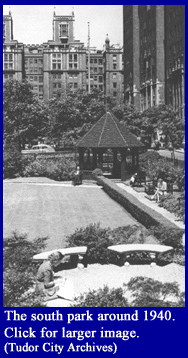 Life in Tudor City from 1941-1968 is chronicled in a gazette-like publication called Tudor City View, which was published by a Tudor City resident. Many of the traditions we hold today, such as caroling at Christmas time, had their beginnings then, as residents gathered 'round the Yule log for good old-fashioned singing. In addition, much of the social life centered around clubs -- the Tudor Players (a theater workshop), the camera club, the art league, the language club, the chorale, and many more. Even the advent of World War II could not dampen the spirit of community as women banded together to form the Women's Volunteer Association with 850 members and a Red Cross Group. Life in Tudor City from 1941-1968 is chronicled in a gazette-like publication called Tudor City View, which was published by a Tudor City resident. Many of the traditions we hold today, such as caroling at Christmas time, had their beginnings then, as residents gathered 'round the Yule log for good old-fashioned singing. In addition, much of the social life centered around clubs -- the Tudor Players (a theater workshop), the camera club, the art league, the language club, the chorale, and many more. Even the advent of World War II could not dampen the spirit of community as women banded together to form the Women's Volunteer Association with 850 members and a Red Cross Group.
An International Event
After the War, another great real estate deal cast Tudor City again into the spotlight. Developer William Zeckendorf , who had acquired most of the land along this part of the East River, convinced John D. Rockefeller to buy the land and make it available as a site for the planned United Nations. Although construction of the UN meant the temporary dislocation of life as usual, Tudor City residents responded with typical verve. The editor of Tudor City View noted, "The result will be impressive, and Tudor City will share with the United Nations in the dignity and impressive nature of the approach."
Creating the approach, however, meant significant changes to the neighborhood. A tunnel that channeled 42nd Street traffic beneath Tudor City to First Avenue was eradicated and replaced by the current bridge. Some row houses and buildings on 42nd Street were razed to allow widening the street to 100 feet and the steps on either side of 42nd Street were created to provide pedestrian access to Tudor City. Tudor City Place itself was widened to sixty feet by taking 22 feet of land along the length of the parks to accommodate additional traffic.
The international character of the United Nations broadened the personality of the community even further. Dignitaries often stayed at the Hotel Tudor where a single room with a private bath went for $3 a night. Social life at Tudor City also included such events as a private party 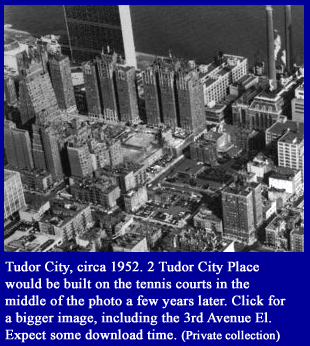 given by a resident for the Marques of Milford Haven, the grandson of Queen Victoria and cousin of the King of England. The changing times also included the razing of the tennis courts in 1954 to make way for Tudor Gardens, now 2 Tudor City Place. given by a resident for the Marques of Milford Haven, the grandson of Queen Victoria and cousin of the King of England. The changing times also included the razing of the tennis courts in 1954 to make way for Tudor Gardens, now 2 Tudor City Place.
A Legacy Preserved
In the 1960s, the French Company sold Tudor City to the Rabinowitz Corporation, which in turn sold it to the Helmsley Corporation in the 1970s. As Tudor City residents are aware, Mr. Helmsley's plans to erect high-rise buildings on the site of the two parks transformed the peaceful community into the mouse that roared. After a prolonged battle, the community prevailed and Mr. Helmsley withdrew his effort. In 1988, The Landmarks Preservation Commission designated Tudor City a Historic District, ensuring that the legacy of the "City on the Hill" will be preserved for many generations.
REFERENCES
In addition to the sources referred by the links noted below, the following references were used.
Tudor City View, 1941-1968, Warren C. Eberle, Editor, Publisher, and Tudor City Resident.
Tudor City Historic District: designation report, Landmarks Preservation Commission, 1988.
Tudor City Greens newsletter, various issues.
"Landmarks Won't Let a Co-Op Fiddle With Its Roof," New York Times, November 26, 1995.
ACKNOWLEDGEMENTS
Special thanks for Nancy Fitzpatrick of the Tudor City Archives for providing some of the extraordinary pictures used here.
See a slide show of additional Tudor City history photos here!
RELATED LINKS:
The Turtle Bay Association neighborhood information.
See the last reference on this page from the NYPL.
The area's history from a local real estate site plus some information on 2 Tudor City Place.
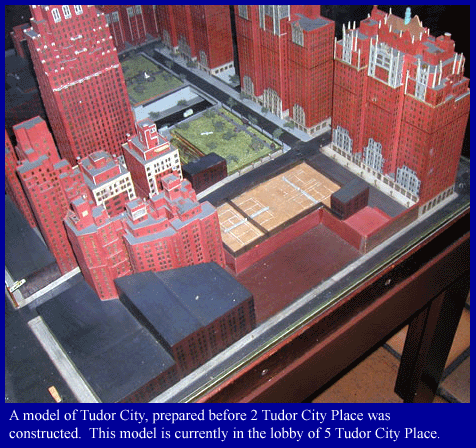
|